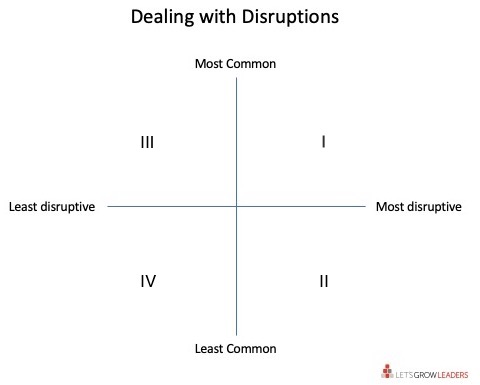Calm the Chaos and Get Your Team Back on Track
Last-minute fire drills, interruptions, and real emergencies can become a permanent way of life. Get your team back on track by planning ahead with these five steps.
It’s a common lament: “It’s so crazy around here. We never know what’s going to happen and there are so many priorities. We’ll be working on something then that gets blown up and we have to focus on the new emergency.”
Distractions and interruptions are a part of life and they can make you crazy if you let them.
5 Steps to Get Your Team Back on Track
If your day seems to be a series of distractions and your team can’t make progress on the strategic priorities that matter most, here are five steps that can help you get your team back on track.
1. Clarify what matters most.
Does your team know the Most Important Thing (M.I.T.)? What strategic priorities matter most? What are the daily and weekly behaviors that will lead to success?
Without the North Star of clearly defined M.I.T.s, your team will always be reactive and distracted by the unexpected and urgent. The first step to get your team back on track is to define clearly what “on track” looks like.
2. Expect the unexpected.
You probably know more about your emergencies, fire drills, and interruptions than you might think. We’ve worked with so many leaders who feel out of control, but when you sit down and talk through the distractions, there are usually just a few causing the majority of the problems.
Take 15 minutes with your team and you can quickly figure out how to expect the unexpected. Start by listing out your most common distractions. Once you have the list, you can map them onto this graph by asking two questions: How commonly does this happen? How disruptive is it?

The items in Quadrant I are the distractions you want to address first. You know they will happen. You know they cost you the most time, money, and energy. (And if you have more time and effort to devote, then move to Quadrant II, then III. You can usually safely ignore IV.)
3. Plan your response.
Now that you know the interruptions and emergencies that cause you the most trouble, it’s time to plan your response.
You have ways of doing your core work, processes that you know work. Build the same processes to handle distractions and return to the MIT. This shortens the time it takes to get your team back on track.
Let’s start with an analogy: a fumbled football.
As soon as that football hits the ground, everyone nearby knows that it’s their job to either pick it up and run or else jump on it and wrap it up in their arms. That’s the plan. Once you have possession of the ball, you get back to your game plan.
Let’s say one of your common, yet important disruptive distractions is a customer who is escalating to your executive office. It’s important and needs to be handled with urgency and care. How can you and your team build a standard way of responding so you minimize the time spent addressing the situation?
Without a process, it’s easy for this urgent situation to involve more people than necessary frenetically working to address the issue, updating their bosses, and duplicating effort.
Maybe your planned response looks like this:
- The executive receives the call and sends it to a designated “on-call” manager who will coordinate response efforts.
- After understanding the situation, the on-call manager contacts the customer and informs them they are working on the situation, and collects any additional information needed.
- The on-call manager also informs the social media team and any other customer communication channels in case the customer is escalating there as well, so all communication is coordinated.
- The on-call manager coordinates the response, contacts the customer, and closes the loop with the executive office.
4. Maintain margin.
One of the most overlooked ways to prevent distractions from overwhelming your day is to plan for them.
If you scheduled your team every day with wall-to-wall meetings and deadlines that must happen today, you have a fragile system with no margin for error. Any interruption will knock over that house of cards and (predictably) ruin your results.
You’ve mapped out your interruptions and how frequently they happen. Besides planning your response, give yourself margin in your calendar to respond. You may not know what will come up, but you know it’s coming.
And if you have one of those magical days where there aren’t any emergencies, fire drills, or interruptions – fantastic! That’s more time to work on your M.I.T. or build relationships with your team.
5. Eliminate causes.
Finally, as you examine your most common and disruptive distractions, ask how you can eliminate them. Is there a problem in your user experience that you can fix? Will a new process prevent those errors? Is there a frequent communication breakdown you can address?
You don’t have to have all the answers. Bring the team together, show them what a successful idea will achieve, and then ask them for their thoughts on how to solve the issue.
How to Get Your Team Back on Track
- Clarify what matters most.
- Expect the unexpected.
- Plan your response.
- Maintain margin.
- Eliminate causes.
It’s easy to let exceptions become the rule and turn your days into whirlwinds of frantic reactivity. Taking a few minutes to identify your most common distractions and building a routine response will save you time, energy, and help get your team back on track, focused on what matters most.
Your Turn
We’d love to hear from you – what would you add? Leave us a comment and share: How do you help your team stay focused despite the inevitable distractions?
 You Might Also Like:
You Might Also Like:
5 Ways Leaders Can Focus When Everything Is Important







Really good stuff! Thanks for sharing.
So glad it’s helpful Vincent!
The football analogy really puts things in perspective in a simple way.
Mentioned it to my team and opened up discussions !
Thanks
Thanks, Sam! I’m so glad it was helpful.
Thanks Sam – good to know that metaphor was useful!
I am a huge football fan and also appreciate the analogy. In people management, fumbles can happen suddenly. Staying on top of the tripping hazards (i.e., attendance) and helping steer away from going “full fumble” is one way to mitigate them.
Thanks Dana – glad the analogy was helpful. Yes, let’s avoid “full fumble!” 🙂
Daily team communication is key in making sure we are all moving towards the main focus (MIT). We often have morning huddles to see how everyone’s plate looks for that day so if others have a lighter load they can assist for more balance.
Nicole,Thanks so much for expanding the conversation! I’m a huge believer in morning huddles.
https://letsgrowleaders.com/2019/01/22/effective-team-huddle/
I love #4) Maintain margin. I work in a production-oriented environment and it’s common for schedules to be based on estimates… I think we can do 5 a day on a good day! But what’s realistic? Only 3 a day, because there is no way everything is going to go smoothly every day. Something will jam up the production process, or an existing product will need attention unexpectedly. In my project management education, I was taught that a person should be expected to produce 6 hours per day at most. An 8-hour day doesn’t necessarily equal 8 hours of production.
Well said Mike! And depending on the day, even 6 might be a big deal toward previous identified priorities vs dealing with the expected unexpecteds. Thanks for adding to the conversation.